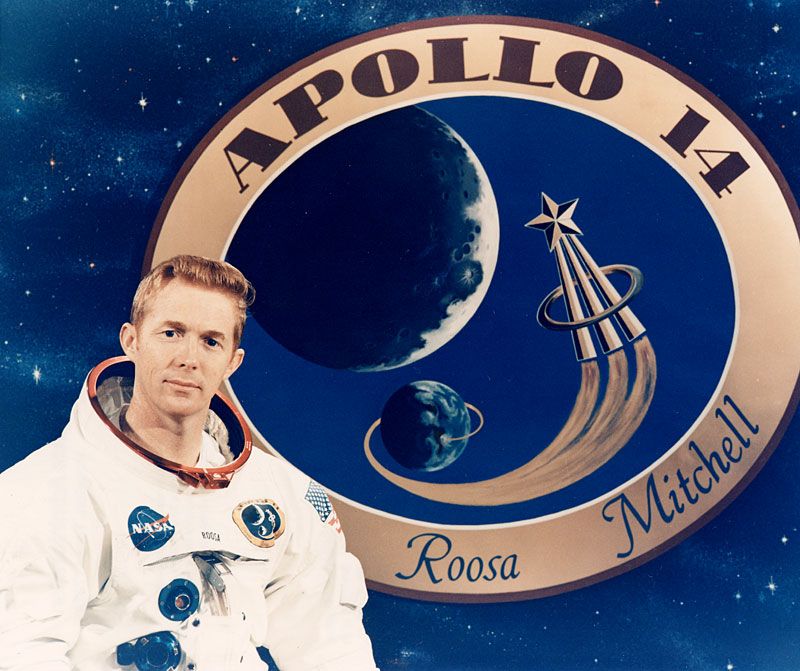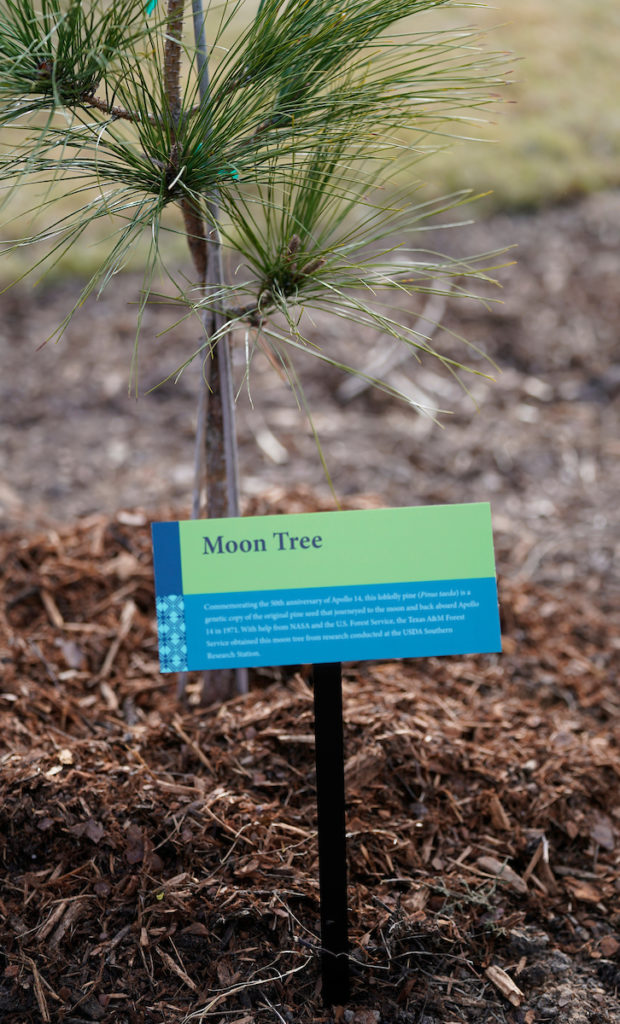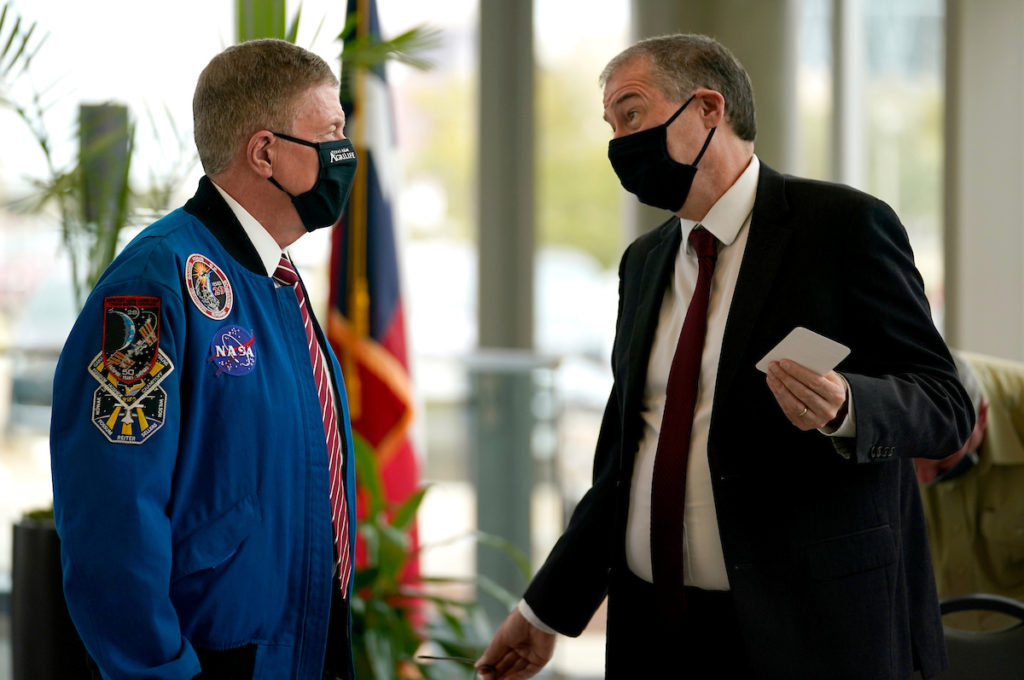‘Moon tree’ at Texas A&M Gardens to celebrate and inspire collaboration
Planting commemorates 50th anniversary of Apollo 14 mission
While most people familiar with the U.S. Space Program’s Apollo missions know about moon rocks, a lesser known but just as interesting outcome of those missions was the NASA and U.S. Forest Service, USFS, collaboration on the moon tree project.

In 1971, as astronauts Alan Shepard and Edgar Mitchell walked on the surface of the Moon during the Apollo 14 mission, Stuart Roosa, a former USFS “smoke jumper,” was orbiting above them in the Kitty Hawk command module.
Inside Roosa’s personal kit were hundreds of seeds from different tree species — loblolly pine, sycamore, sweetgum, redwood and Douglas fir pine — provided for the mission by the USFS.
Once the astronauts returned to Earth, the seeds were given to the USFS to be germinated. The resulting viable seedlings produced from these seeds were dubbed “moon trees.” Many were planted throughout the U.S., mostly in conjunction with the nation’s bicentennial celebration, and in other countries.
In the U.S., moon trees can also be found on the grounds of the White House, Washington Square, Valley Forge, the International Forest of Friendship and at various universities and NASA centers. They have also been planted in Brazil and Switzerland, and one was presented to the Emperor of Japan.
A moon tree was also planted at Roosa’s home in Austin in 1978.
These trees and their descendants continue to stand as a tribute to the Apollo program and to Roosa.
Moon tree planting at Texas A&M
One of the moon tree descendants, a loblolly pine, was planted Feb. 8 at The Gardens at Texas A&M University. The planting was to commemorate the 50th anniversary of the Apollo 14 mission that occurred Jan. 31 to Feb. 9 in 1971.

“The Texas A&M Forest Service acquired a genetic copy of an original loblolly pine moon tree whose seed journeyed to the moon and back aboard Apollo 14,” said Texas state forester and director of Texas A&M Forest Service Tom Boggus at the planting. “The tree was obtained from research conducted at the U.S. Department of Agriculture Southern Research Station.”
Boggus said the planting was made possible through a collaboration between the USFS Southern Research Station, Southern Institute of Forest Genetics and the Texas A&M Forest Service Western Gulf Forest Tree Improvement Program.
He also noted the Texas A&M Forest Service formed the first genetic tree improvement program in the nation in 1951. This program, as well as the Western Gulf Forest Tree Improvement Program, which began in 1969, were established to support research in forest genetics, selection, breeding and testing, along with technology transfer for long-term regeneration of forests.
In his remarks, Boggus emphasized the importance of forests to humans and animals for oxygen and shelter, as well as for their role in filtering water, protecting watersheds and preventing soil erosion. Boggus expressed his deep appreciation for the long-standing collaborative relationship between the Texas A&M Forest Service and NASA.
The moon tree as a symbol for inspiration
Patrick J. Stover, Ph.D., vice chancellor of Texas A&M AgriLife, dean of the College of Agriculture and Life Sciences and director of Texas A&M AgriLife Research, said the planting of the moon tree at the teaching gardens would stand as a “symbol of what is possible through scientific advancement and research.”

He also said having a moon tree on campus was fitting for both Texas A&M AgriLife and The Gardens.
“We are hoping this moon tree will serve as an inspiration to our students and others,” Stover said. “The gardens are supposed to represent the past, present and future of Texas agriculture, and the moon tree is a representation of the future and what all can be done by working together.”
He also noted the moon tree was a representation of bringing together the important concepts of agricultural education, natural resource conservation land management and tree species protection.
“Forests are vital for both human physical and mental health,” Stover said.
Though unable to attend, Rosemary Roosa, daughter of astronaut Col. Stuart Roosa and president of the Moon Tree Foundation, delivered a virtual message to planting attendees.
In her message, she related the story of her father’s involvement in the Apollo program and how this corresponded with his previous experience at the USFS.
“My father loved the forest and he used to take the family into the woods so we could experience nature,” she recounted. “The Moon Tree Foundation motto is ‘Planting the Seed of Inspiration,’ and I can think of no better place to plant this tree than where young people at the university can look at it and be inspired by it.”
She also said she hopes a seed or seeds from moon trees planted here on Earth would one day be brought back to the moon – possibly on the upcoming Artemis mission to the moon slated for 2024.
Why the loblolly pine?
Jan Davis, a deputy regional forester with the Southern Region of the USDA Forest Service, also spoke at the planting. The service’s Southern Region encompasses 13 states, including Texas, as well as Puerto Rico and the Virgin Islands. Known as Region 8, it oversees more than 13 million acres of land, which includes 14 national forests and grasslands.
Davis explained why the loblolly pine, which is the commonly encountered pine in Texas and forms extensive forests in the eastern part of the state, was selected as the tree species to be planted at Texas A&M.
She said the loblolly pine seeds, such as the one that produced the Texas A&M moon tree, were selected for the Apollo 14 mission because researchers “realized their genetic makeup was much like the solar system where outer space and inner space meet and that could, in theory, and also in Roosa’s mind, hold a key to the evolution of trees.”
Davis explained that after the seeds that orbited the moon were sprouted back on Earth, some were distributed to research centers in the south. It was a scion or “offspring” of one of these trees that was planted at the teaching garden.
She also noted that in the years since the moon trees orbited the earth, the USFS, Texas A&M Forest Service and NASA have “crossed paths at other times.”
“Both agencies were instrumental in the recovery work after the tragic event of the Columbia Space Shuttle explosion in 2003,” she said. “Then we crossed paths again in 2005, when Col. Michael Fossum was keynote speaker at the Society of American Foresters National Convention in Fort Worth and shared his beliefs in commonalities between space and forest exploration.”
Texas A&M Forest Service partnership with NASA
Fossum, a retired NASA astronaut, chief operating officer at Texas A&M University at Galveston and superintendent of the Texas A&M Maritime Academy, also spoke at the planting.

He also attended as a representative for NASA and its Johnson Space Center having been an astronaut and the commander of Expedition 29 aboard the International Space Station in 2011.
In his remarks, Fossum thanked the Texas A&M Forest Service for its role in helping “solve the mystery of the Space Shuttle Columbia disaster and recovery” that took the lives of seven crew members. Several pieces of the craft were strewn over remote areas of the state and the service helped locate and identify them.
He also lauded the service for the exceptional work it did for the state in fighting the Bastrop County wildfires.
“As the space station passed over Texas in 2011, I was able to spot some of the wildfire activity and was told it was the fire that had spread throughout the Bastrop State Park,” he said. “That was where I had taken my Boy Scout troop years before, and the sight of that area burning really affected me.”
Fossum also spoke about the original experiment done with the moon tree seeds as well as their connection to Roosa and his love of the forest. He noted, however, the scientific conclusion that the seeds that were sent into space were unchanged by the experience was “hogwash” — at least in a figurative sense.
“My dad’s wedding ring was with me on the space station for 164 days and it’s changed forever,” he said. “My Aggie ring has been on all three missions and has 77 million miles on it. It’s still a hunk of precious Aggie gold, but it’s changed.”
Fossum said he is looking forward to the future of the space program and the eventuality of a human landing on Mars. He noted that for such a long journey it would likely be necessary for the astronauts to produce some of their own food during the journey, and new technology would be required to make that a reality.
“I have absolutely no doubt that one day there will be human footprints on Mars,” he said. “When that happens, I pray there will be at least one American flag on their shoulder and at least one Aggie ring carefully hidden inside their glove.”


